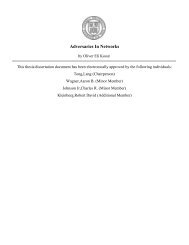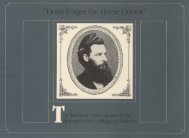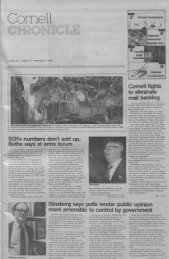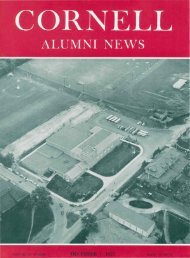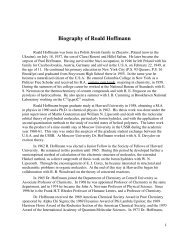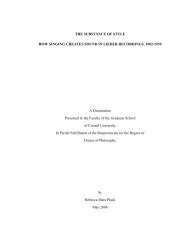Cornell Alumni News - eCommons@Cornell - Cornell University
Cornell Alumni News - eCommons@Cornell - Cornell University
Cornell Alumni News - eCommons@Cornell - Cornell University
Create successful ePaper yourself
Turn your PDF publications into a flip-book with our unique Google optimized e-Paper software.
potent drives toward self-destruction,<br />
hatred and death. He quotes Tolstoy:<br />
"Art and art only can cause violence to be<br />
set aside."<br />
Read has no universal plan to implement<br />
his views. He has no faith in power<br />
structure groups like UNESCO to bring<br />
about any significant change. If a<br />
change comes at all, it will have to come<br />
from individuals in the educational process<br />
who build centers of affirmative creative<br />
activity that will in turn influence<br />
others. The book should be useful reading<br />
for all those educators who are preoccupied<br />
with the large-scale public relations<br />
and social aspects of education, but who<br />
know nothing about the educative power<br />
of individual creative action.<br />
ROGER FRY by Virginia Woolf. Harcourt.<br />
1940.<br />
At first glance this volume gives off a<br />
sad air of arty British eccentricity and lost<br />
causes. Numerous illustrations of Fry's<br />
inept paintings and the wan dutiful style<br />
of the text are initially discouraging. However,<br />
in spite of these obstacles to respect.<br />
Fry comes out in this account as an admirable<br />
and worthy man.<br />
He was the Anglo-Protestant puritan<br />
turned pagan, but without loss of zeal. He<br />
smote the Philistines and carried on a Messianic<br />
campaign against the dehumanizing<br />
impact of Victorian religiosity and<br />
Twentieth Century technology. The emotional<br />
postures of righting wrong and rebelling<br />
against British materialism sustained<br />
his efforts but did not prevent him<br />
from making aesthetic discoveries. He<br />
was an intelligent, open-eyed man, capable<br />
of detached, yet concentrated attention to<br />
the vast range of visual creations available<br />
in his day. The dated gestures of his life<br />
—his painting, the organization of the<br />
Omega society, the theatrical lectures, and<br />
didactic exhibitions—do not obscure the<br />
fact that he looked at the art of the world<br />
with an independent eye and that he<br />
took the trouble to analyze and relate his<br />
reactions.<br />
His objective concern with observable<br />
formal structure, free of the limiting considerations<br />
of conventional drawing and<br />
subject matter, has affected our way of seeing.<br />
His contagious enthusiasm and generosity<br />
seem strange in our mean-spirited<br />
age, and his emphasis on the importance<br />
of formal values is impatiently rejected<br />
by modern academicians of the "New."<br />
However, for anyone interested in painting<br />
as a long-time enterprise, this biography<br />
and Fry's books, Cezanne, Vision and<br />
Design, and Transformations are still relevant<br />
and interesting.<br />
THE JOURNAL OF EUGENE DELACROIX<br />
Translated by Walter Pach. Grove. 1961.<br />
Delacroix's Journal and the letters of<br />
Van Gogh are two basic sources of insight<br />
into the nature of European painting of<br />
the nineteenth century. Both are the works<br />
of ardent, intelligent, and articulate men<br />
whose writings reveal their life and time,<br />
their feelings, and their awareness of the<br />
art of painting. Although poles apart in<br />
worldly status and seeming success, these<br />
artists shared a common love of nature,<br />
color, and the process of making marks<br />
on canvas with brushes and oil paint.<br />
Delacroix was a paradoxical man who<br />
loved the bizarre and exotic and spoke<br />
seriously of the "sublime." He was a close<br />
friend of Gericault and Chopin and, like<br />
them, seemed the true romantic artist. Yet<br />
he admired Mozart above all composers,<br />
observed the political and social life of his<br />
time with cool perception, was fiercely<br />
aristocratic, opposed to progress, and pessimistic<br />
about human affairs in general.<br />
He saw his creative efforts poised<br />
against the omnipresent reality of death.<br />
He recognized boredom as the other great<br />
enemy. To contend with these two threats,<br />
he advocated for himself a life of constant<br />
creative activity, reading, and contemplation.<br />
He was throughly engaged in the<br />
intellectual and cultural life of Paris in<br />
his day. He knew many of the great creative<br />
men and women of his time. He knew<br />
the world of money and power. This fascinating<br />
journal not only provides a vivid<br />
account of his life at that worldly level<br />
but also reveals the deeper existence of<br />
his love, his thought, and his work.<br />
Most of the illustrations in the volume<br />
are printed in a miserable fuzzy sepia tone<br />
and do the artist great injustice.<br />
MOZART THE DRAMATIST by Brigid<br />
Brophy. London. Faber. 1964.<br />
For me, no other creations of mankind<br />
are as moving as the operas of Mozart.<br />
They seem to contain all the essential<br />
energies and passions of human experience,<br />
projected in forms of irresistible classic<br />
beauty. Consequently, I am well-disposed<br />
toward a book which states at<br />
the outset, "Mozart stands at the very<br />
pinnacle of Parnassus." Brigid Brophy<br />
proceeds from there to apply her formidable<br />
intelligence, learning, and wit to<br />
the subject of Mozart's dramatic and psychological<br />
power.<br />
She maintains that Mozart was the true<br />
dramatist of the operas, although he depended<br />
on various writers to produce<br />
the libretti. Quoting from his letters and<br />
deducing internal evidence in the scores,<br />
she makes out a good case for the view<br />
that Mozart provided the psychological<br />
framework for the operas, and that his<br />
dramatic sense dominated their development.<br />
She relates the psychological theme<br />
of his operas to certain guiding convictions<br />
and preoccupations of the Enlightenment.<br />
She uses Freudian concepts to<br />
reveal how psychic patterns of the Eighteenth<br />
Century and of Mozart's private life<br />
are reflected in the operas.<br />
The book is full of interesting insights.<br />
Chapter headings such as: "Women and<br />
Opera," "Singing and Theology," "Anarchy,<br />
Impotence and Classicism," "Compulsive<br />
Seduction," "Hell, Love and Society,"<br />
"Don Giovanni and Hamlet" give<br />
an indication of the range of her exploration.<br />
All this is interesting to read about, even<br />
though it may be peripheral. No matter<br />
how subtly Mozart relates his score to the<br />
libretto (as in Cosi Fan Tutte), what really<br />
counts is the music. Indeed, the ironic<br />
and poignant disparity between the mere<br />
words of the text and the grand verve<br />
and tragic power of the music is one of<br />
the reasons the operas are so appealing.<br />
However, Miss Brophy's literary and<br />
psychological probing does add another<br />
dimension to our perception of the genius<br />
of Mozart.<br />
THE ANXIOUS OBJECT; ART TODAY AND<br />
ITS AUDIENCE by Harold Rosenberg. London.<br />
Faber. 1964.<br />
Here is an example of the current demand<br />
for Instant Art History.<br />
Rosenberg is a smart, tough-minded,<br />
New York literary man turned art analyst.<br />
In this collection of magazine articles he<br />
transforms the painters of the New York<br />
School into legendary prophets and heroes<br />
then assigns them niches in his own<br />
chauvinistic Pantheon. He writes in an<br />
aggressive, omniscient style, full of paradoxes<br />
and perverse twists that jolt the<br />
reader. It is hard to tell how much of<br />
this is literary fun and games, promotional<br />
mythmaking, or serious art criticism.<br />
The author has been most deeply concerned<br />
with the action painters of the<br />
Fifties, and consequently they loom up<br />
large in the book. As that school is now<br />
either written off by currently dominant<br />
tastemakers as ancient art history or dismissed<br />
as a romantic bore, these essays<br />
are already beginning to have a dated air.<br />
For example, it now seems incredible that




